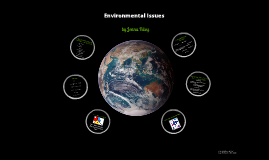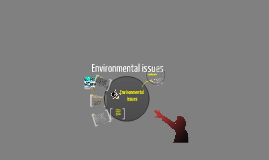Environmental Issues
Transcript: Envir nmental Issues Environmental issues are negative aspects of human activity on the biophysical environment. The level of understanding of Earth has increased markedly in recent times through science especially with the application of the scientific method. Environmental science is now a multi-disciplinary academic study taught and researched at many universities. This is used as a basis for addressing environmental issues. Environmental organization Environmental issues are addressed at a regional, nation or international level by government organisations. The largest international agency, set up in 1972, is the United Nations Environmentt Programme. International non-governmental organizations include Greenpeace, Friends of the Earth and World Wide Fund for Nature. Governments enact environmental policy and enforce environmental law and this is done to differing degrees around the world. Solution Sustainability is the key to preventing or reducing the effect of environmental issues. There is now clear scientific evidence that humanity is living unsustainably, and that an unprecedented collective effort is needed to return human use of natural resources to within sustainable limits. For humans to live sustainably, the Earth's resources must be used at a rate at which they can be replenished. 1. Climate Change On the broadest scale, the rate at which energy is received from the sun and the rate at which it is lost to space determine the equilibrium temperature and climate of Earth. This energy is distributed around the globe by winds, ocean currents, and other mechanisms to affect the climates of different regions. Factors that can shape climate are called climate forcings or "forcing mechanisms”. On the broadest scale, the rate at which energy is received from the sun and the rate at which it is lost to space determine the equilibrium temperature and climate of Earth. This energy is distributed around the globe by winds, ocean currents, and other mechanisms to affect the climates of different regions. Factors that can shape climate are called climate forcings or "forcing mechanisms”. These include processes such as variations in solar radiation, deviations in the Earth's orbit, mountain-building and continental drift, and changes in greenhouse gas concentrations. 2. Conservation Conservation is an ethic of resource use, allocation, and protection. Its primary focus is upon maintaining the health of the natural world, its: fisheries habitats biological diversity biological conservation as being a philosophy of managing the environment in a manner that does not despoil, exhaust or extinguish Secondary focus is on materials conservation and energy conservation, which are seen as important to protect the natural world. Those who follow the conservation ethic and, especially, those who advocate or work toward conservation goals are termed conservationists. To protect sea life from extinction due to overfishing is another commonly stated goal of conservation — ensuring that "some will be available for our children" to continue a way of life. The consumer conservation ethic is sometimes expressed by the four R's: " Rethink, Reduce, Recycle, Repair" This social ethic primarily relates to local purchasing, moral purchasing, the sustained, and efficient use of renewable resources, the moderation of destructive use of finite resources, and the prevention of harm to common resources such as air and water quality, the natural functions of a living earth, and cultural values in a built environment. “The conservation of natural resources is the fundamental problem. Unless we solve that problem, it will avail us little to solve all others”. -Theodore Roosevelt Protected areas in developing countries, where probably as many as 70-80 percent of the species of the world live, still enjoy very little effective management and protection. Some countries, such as Mexico, have non-profit civil organizations and land owners dedicated to protect vast private property 3. Environmental impact of the Energy Industry The environmental impact of the energy industry is diverse. Energy has been harnessed by humans for millennia. Initially it was with the use of fire for light, heat, cooking and for safety, and its use can be traced back at least 1.9 million years. In recent years there has been a trend towards the increased commercialization of various renewable energy sources. In the real world, consumption of fossil fuel resources lead to global warming and climate change. However in many parts of the world little change is being made. The majority of greenhouses gas emissions are due to burning fossil fuels with most of the rest due to deforestation. There is a highly publicized denial of climate change but the vast majority of scientists working in climatology accept that it is due to human activity. Biofuel use Biofuel is defined as solid, liquid or gaseous fuel obtained from relatively recently lifeless or living biological

















